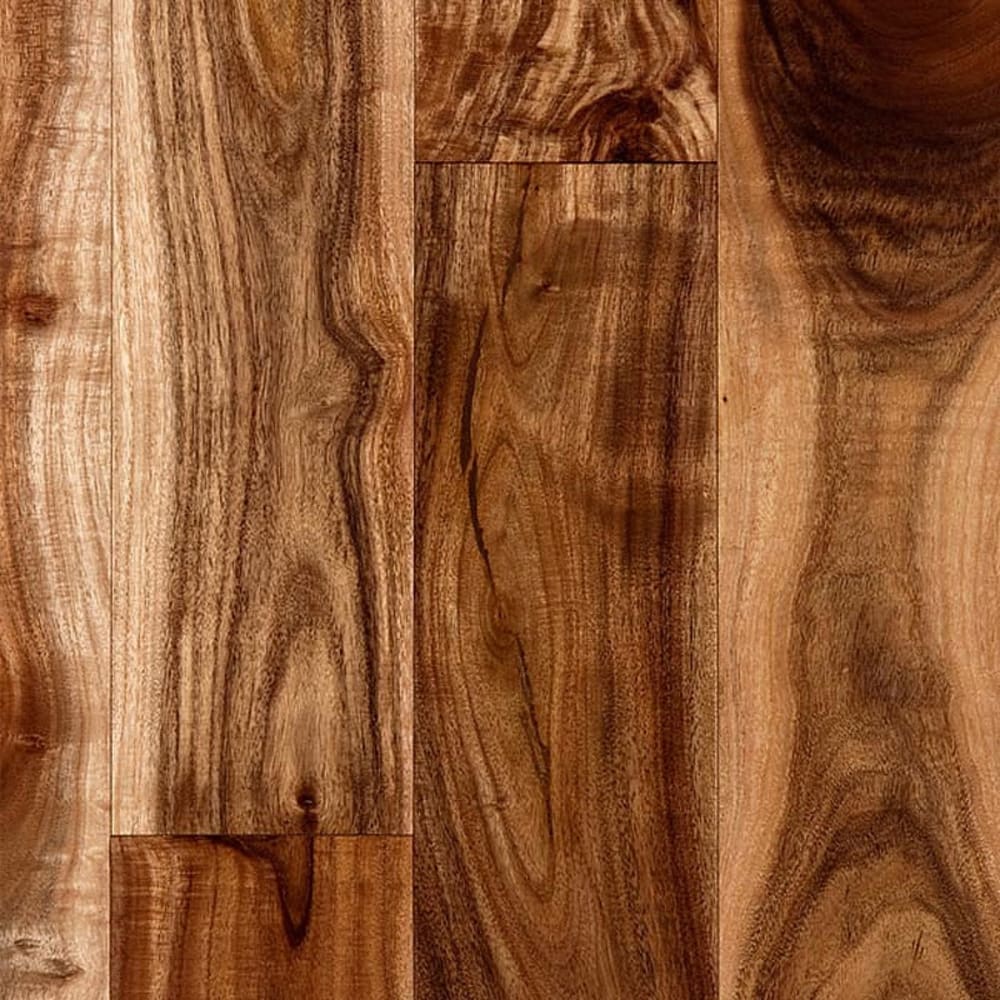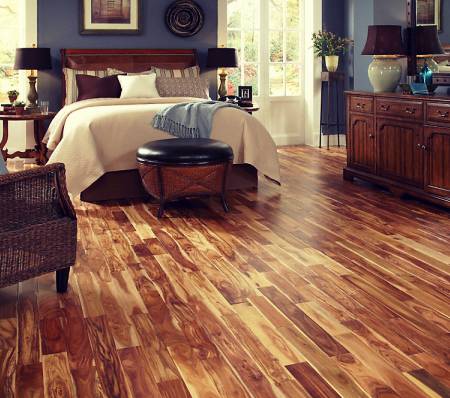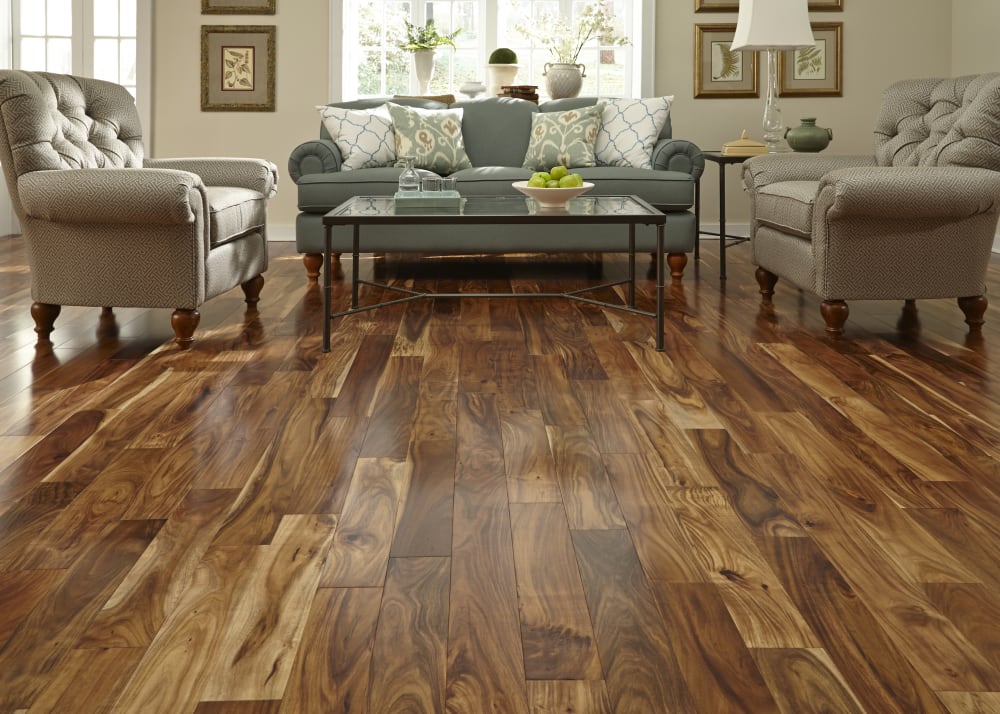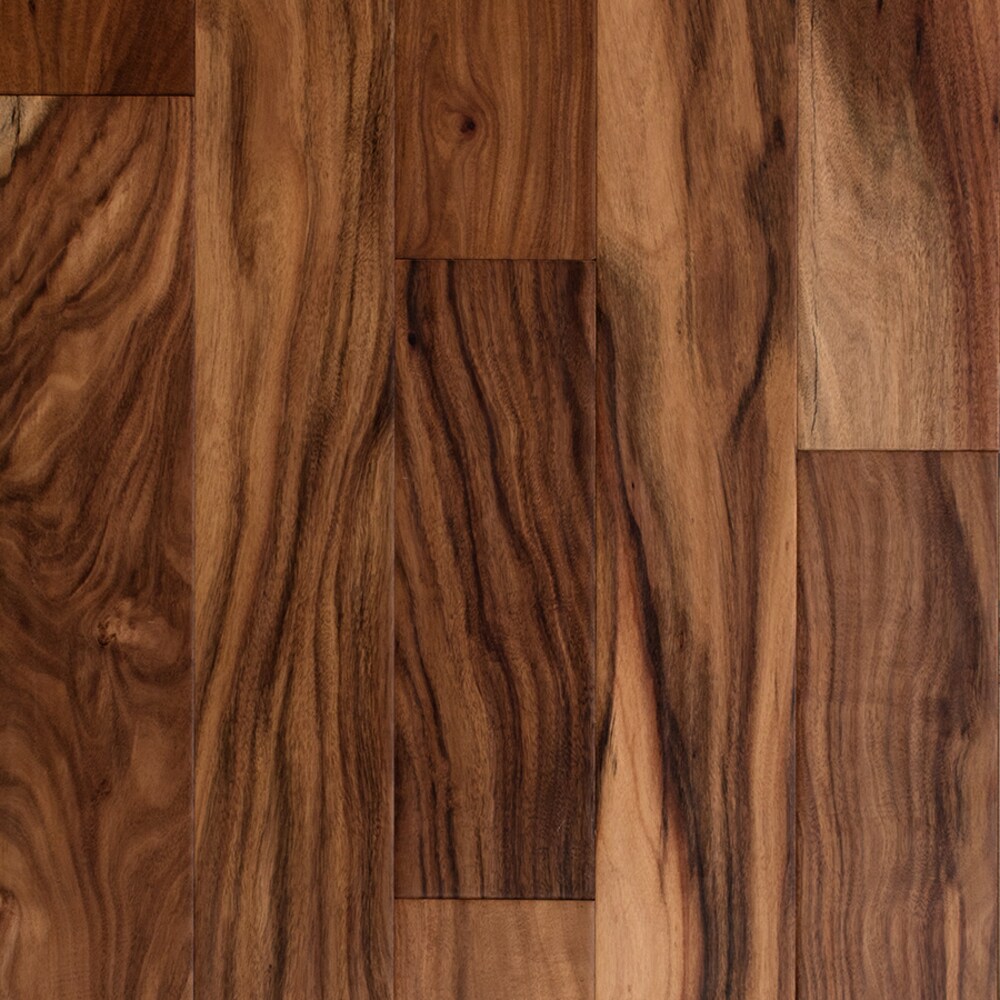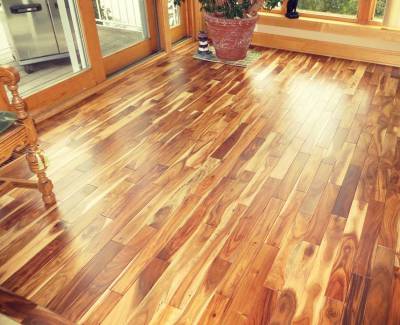Understanding Acacia and Bamboo Flooring
Acacia and bamboo flooring are two popular options for homeowners seeking durable, attractive flooring solutions. Understanding the characteristics and properties of each can help you make an informed decision for your home. Let’s talk about the specifics of acacia and bamboo flooring:
- Acacia Flooring: Acacia flooring is sourced from the acacia tree, which is native to Australia and Africa. It is known for its distinct grain patterns and rich, warm hues ranging from golden browns to deep chocolates. Acacia flooring is prized for its natural beauty and unique variations, making each plank a one-of-a-kind piece.
- Bamboo Flooring: Bamboo flooring, on the other hand, is derived from the fast-growing bamboo plant, which is native to Asia. Bamboo flooring typically features a sleek, contemporary look with a uniform grain pattern. It is available in a variety of shades, including natural, carbonized (darkened through a heating process), and stained finishes.
- Construction: Acacia flooring is typically available in both solid hardwood and engineered formats. Solid acacia planks are made from a single piece of wood and offer superior durability, while engineered acacia consists of multiple layers with a hardwood veneer on top. Bamboo flooring is primarily available in engineered formats, with strands of bamboo compressed and bonded together to create durable planks.
- Usage: Both acacia and bamboo flooring are suitable for most interior spaces, including living rooms, bedrooms, kitchens, and hallways. However, acacia flooring is known for its natural resistance to moisture, making it a popular choice for areas prone to spills or humidity, such as kitchens and bathrooms. Bamboo flooring is also moisture-resistant but may require additional sealing in high-moisture environments.
- Cost: In terms of cost, acacia flooring tends to be more expensive than bamboo flooring due to its scarcity and the labor-intensive process of sourcing and manufacturing. Bamboo flooring offers a budget-friendly alternative with comparable durability and aesthetic appeal.
- Lifespan: When properly maintained, both acacia and bamboo flooring can last for decades. Regular cleaning and maintenance, such as sweeping or vacuuming to remove dirt and debris, and occasional polishing or refinishing, can help prolong the lifespan of your flooring investment.

Comparing the Strength of Acacia and Bamboo
Durability is a key consideration when selecting flooring materials for your home. Acacia and bamboo flooring are both renowned for their strength and resilience, but how do they compare in terms of hardness and durability? Let’s examine the factors that contribute to the durability of acacia and bamboo flooring:
Hardness Ratings: Hardness is measured using the Janka hardness test, which evaluates the resistance of wood to denting and wear. Acacia flooring typically has a Janka hardness rating ranging from 1,750 to 2,300 pounds-force (lbf), making it highly durable and suitable for high-traffic areas. Bamboo flooring, depending on the species and manufacturing process, can have a Janka hardness rating comparable to oak or even higher, with ratings ranging from 1,200 to 5,000 lbf.
Natural Resistance: Acacia flooring is naturally resistant to scratches, dents, and wear due to its dense grain structure and high tannin content. This makes it an excellent choice for households with pets or young children. Bamboo flooring, although durable, may be more susceptible to scratching and denting in comparison, particularly in areas with heavy foot traffic or furniture movement.
Moisture Resistance: Both acacia and bamboo flooring exhibit natural resistance to moisture, making them suitable for use in kitchens, bathrooms, and other high-moisture environments. However, it’s essential to properly seal and maintain bamboo flooring to prevent water damage and warping over time.
Finish and Coating: The finish and coating applied to acacia and bamboo flooring can significantly impact their durability and longevity. Opt for high-quality finishes, such as aluminum oxide or polyurethane, which provide an extra layer of protection against scratches, stains, and UV damage. Regular maintenance, such as sweeping, mopping with a damp cloth, and avoiding harsh chemicals, can help preserve the integrity of the finish and prolong the life of your flooring.
Installation Method: The installation method can also affect the durability of acacia and bamboo flooring. Proper acclimatization, subfloor preparation, and installation techniques, such as floating, nail-down, or glue-down methods, can ensure a stable and long-lasting floor surface. Consult with a professional installer to determine the best installation approach for your specific flooring needs.
Warranty and Guarantees: When purchasing acacia or bamboo flooring, inquire about warranties and guarantees offered by the manufacturer or retailer. A comprehensive warranty can provide peace of mind and protection against manufacturing defects, premature wear, and other issues that may affect the durability of your flooring investment.
Contrasting the Natural Beauty of Acacia and Bamboo
The aesthetic appeal of flooring plays a significant role in enhancing the overall look and feel of your home. Acacia and bamboo flooring offer distinct visual characteristics and natural beauty that can complement a variety of interior design styles. Let’s explore the differences in appearance and aesthetics between acacia and bamboo flooring:
Grain Patterns: Acacia flooring is renowned for its striking grain patterns and rich, varied hues, ranging from golden yellows and reddish-browns to deep chocolates and dark grays. The distinctive knots swirls, and mineral streaks present in acacia wood add depth and character to each plank, creating a visually dynamic and unique floor surface. In contrast, bamboo flooring typically features a more uniform and consistent grain pattern, with subtle variations in color and texture.
Color Variations: Acacia flooring offers a wide range of color variations and tones, making it a versatile choice for homeowners seeking a floor with character and warmth. From light, honey-colored planks to dark, espresso-toned boards, acacia flooring can complement a variety of interior color schemes and decor styles. Bamboo flooring is available in natural, carbonized, and stained finishes, offering options for both traditional and contemporary design aesthetics.
Texture and Surface Finish: The texture and surface finish of acacia and bamboo flooring can vary depending on the manufacturing process and desired look. Acacia flooring may feature hand-scraped, distressed, or wire-brushed textures that enhance its rustic charm and authenticity. Bamboo flooring typically has a smooth, sleek surface that lends itself well to modern and minimalist interiors. Both flooring options can be finished with matte, satin, or high-gloss coatings to enhance durability and visual appeal.
Visual Impact: The visual impact of acacia and bamboo flooring can transform the atmosphere of a room, creating a sense of warmth, elegance, or contemporary sophistication. Acacia flooring adds a touch of natural beauty and organic warmth to traditional, rustic, or eclectic spaces, while bamboo flooring lends a sleek, modern aesthetic to minimalist, Scandinavian, or Asian-inspired interiors.
Light Reflectivity: The light reflectivity of flooring can influence the perceived size and brightness of a room. Acacia flooring with lighter tones and open-grain patterns can reflect more light, creating a sense of spaciousness and airiness in smaller or dimly lit spaces. Bamboo flooring with darker finishes or carbonized strands may absorb more light, adding depth and coziness to larger or sunlit rooms.
Long-Term Appearance: Over time, acacia and bamboo flooring may develop a natural patina and character that enhance their beauty and appeal. Regular maintenance, such as cleaning, polishing, and refinishing, can help preserve the original color and luster of both flooring options for years to come.
Ease of Installation and Care for Acacia vs. Bamboo
The ease of installation and maintenance are essential factors to consider when selecting flooring for your home. Acacia and bamboo flooring offer distinct advantages and considerations in terms of installation methods, upkeep requirements, and long-term maintenance. Let’s explore the differences in installation and maintenance between acacia and bamboo flooring:
Installation Method: Acacia flooring is typically available in both solid hardwood and engineered formats, offering flexibility in installation options. Solid acacia planks can be installed using nail-down or glue-down methods, while engineered acacia can be installed as floating floors or glued directly to the subfloor. Bamboo flooring is primarily available in engineered formats, with tongue-and-groove planks that can be floated, glued, or nailed down for a secure and stable installation.
Subfloor Compatibility: Both acacia and bamboo flooring are compatible with a variety of subfloor materials, including plywood, concrete, and existing hardwood floors. Proper subfloor preparation, such as leveling, moisture testing, and underlayment installation, is essential to ensure a smooth and stable surface for installation.
DIY vs. Professional Installation: While DIY installation is possible for both acacia and bamboo flooring, professional installation is recommended for optimal results, especially for engineered formats or challenging installation environments. A professional installer can ensure proper acclimatization, subfloor preparation, and installation techniques to minimize the risk of issues such as gaps, buckling, or unevenness.
Maintenance Requirements: Acacia and bamboo flooring require similar maintenance routines to preserve their beauty and durability. Regular cleaning with a soft broom, vacuum, or microfiber mop can remove dirt, dust, and debris without scratching or damaging the surface. Avoid using harsh chemicals, abrasive cleaners, or steam mops, as they can dull the finish and strip away protective coatings.
Spot Cleaning and Stain Removal: For spot cleaning and stain removal, use a damp cloth or sponge with a mild detergent or hardwood floor cleaner to gently scrub away spills, stains, or sticky residue. Wipe dry immediately to prevent water damage or discoloration. For stubborn stains or marks, consult the manufacturer’s recommendations or seek professional assistance.
Refinishing and Repair: Over time, acacia and bamboo flooring may show signs of wear, scratches, or surface damage. Refinishing or repairing the flooring can help restore its original beauty and extend its lifespan. Consult with a professional flooring contractor to assess the condition of your flooring and recommend appropriate refinishing or repair solutions.
The Sustainability of Acacia and Bamboo Flooring
Environmental sustainability is an increasingly important consideration for homeowners seeking eco-friendly flooring options. Acacia and bamboo flooring offer distinct advantages in terms of sustainability, renewable resources, and environmental impact. Let’s examine the environmental characteristics and considerations of acacia and bamboo flooring:
Renewable Resources: Acacia and bamboo are both renewable resources that offer sustainable alternatives to traditional hardwoods. Acacia trees are fast-growing and resilient, with a rapid growth rate that makes them ideal for sustainable forestry practices. Bamboo is one of the fastest-growing plants on Earth, with some species capable of reaching maturity in as little as three to five years, making it an abundant and renewable source of material for flooring and other applications.
Harvesting Practices: Sustainable harvesting practices are essential to ensure the long-term viability of acacia and bamboo forests. Responsible forestry management techniques, such as selective harvesting, reforestation, and habitat conservation, help to maintain the health and biodiversity of natural ecosystems while supporting local communities and economies.
Certifications and Standards: Look for acacia and bamboo flooring products that carry certifications and adhere to environmental standards, such as Forest Stewardship Council (FSC) certification, which ensures that the wood or bamboo is sourced from responsibly managed forests and meets strict social, environmental, and economic criteria. Other certifications, such as the Sustainable Forestry Initiative (SFI) and Programme for the Endorsement of Forest Certification (PEFC), also indicate sustainable forestry practices and responsible sourcing.
Low VOC Emissions: Volatile organic compounds (VOCs) are chemicals emitted from certain building materials, including flooring, that can negatively impact indoor air quality and human health. Choose acacia and bamboo flooring products that are certified low-VOC or emit minimal emissions to reduce the risk of indoor air pollution and promote a healthier living environment for your family.
Carbon Footprint: Consider the carbon footprint of acacia and bamboo flooring throughout their lifecycle, from harvesting and manufacturing to transportation and installation. Bamboo flooring generally has a lower carbon footprint than traditional hardwoods due to its rapid growth rate and efficient manufacturing process. Acacia flooring, while also sustainable, may have a slightly higher carbon footprint depending on factors such as sourcing, transportation distance, and manufacturing methods.
Longevity and Durability: The longevity and durability of acacia and bamboo flooring play a significant role in their overall environmental impact. Choose high-quality flooring products with durable finishes and long lifespans to minimize the need for replacement and reduce waste over time. Proper maintenance and care can further extend the lifespan of your flooring investment, ensuring maximum environmental benefits.
Cost Considerations Between Acacia and Bamboo Flooring
Cost is a significant factor for many homeowners when selecting flooring materials for their homes. Acacia and bamboo flooring offer distinct cost advantages and considerations based on factors such as material availability, manufacturing processes, installation methods, and long-term maintenance. Let’s discuss the cost differences between acacia and bamboo flooring:
Material Availability: Acacia flooring is sourced from acacia trees, which are native to Australia and Africa. The limited availability of acacia wood and the labor-intensive process of sourcing and manufacturing can contribute to higher production costs and retail prices. Bamboo flooring, in contrast, is derived from bamboo plants, which are fast-growing and abundant, making bamboo flooring more readily available and cost-effective.
Manufacturing Processes: The manufacturing processes for acacia and bamboo flooring can vary in complexity and cost. Acacia flooring is available in both solid hardwood and engineered formats, with solid acacia typically commanding a higher price due to its superior durability and longevity. Engineered acacia offers a more budget-friendly alternative without compromising on quality or aesthetic appeal. Bamboo flooring is primarily available in engineered formats, with manufacturing processes that involve cutting, pressing, and finishing bamboo strands to create durable planks.
Installation Costs: Installation costs for acacia and bamboo flooring may vary depending on factors such as the installation method, subfloor condition, and labor rates in your area. Both acacia and bamboo flooring can be installed using nail-down, glue-down, or floating methods, with DIY installation offering potential cost savings compared to professional installation services. However, professional installation is recommended for optimal results, especially for engineered formats or challenging installation environments.
Long-Term Maintenance: Consider the long-term maintenance costs associated with acacia and bamboo flooring, including routine cleaning, refinishing, and repair. While both flooring options offer durable finishes and minimal maintenance requirements, bamboo flooring may require additional sealing or coating to enhance moisture resistance and durability over time. Factor in the cost of cleaning products, refinishing materials, and professional maintenance services when budgeting for your flooring investment.
Warranty Coverage: Review the warranty coverage offered by manufacturers or retailers for acacia and bamboo flooring products. A comprehensive warranty can provide peace of mind and protection against manufacturing defects, premature wear, and other issues that may affect the longevity and performance of your flooring investment. Compare warranty terms, coverage periods, and exclusions to assess the overall value and cost-effectiveness of different flooring options.
Overall Value: When comparing the cost of acacia and bamboo flooring, consider the overall value and benefits of each option to your budget, lifestyle, and aesthetic preferences. While acacia flooring may have a higher upfront cost, its unique beauty, durability, and longevity can provide lasting value and enjoyment for years to come. Bamboo flooring offers a budget-friendly alternative with comparable durability and aesthetic appeal, making it an attractive option for cost-conscious homeowners.
Acacia Flooring – Your Ultimate Guide (Including Infographic)
1/2 in. Acacia Quick Click Engineered Hardwood Flooring 4.75 in. Wide
allen + roth Natural Acacia 5-in Wide x 3/8-in Thick Handscraped
Acacia Flooring – Your Ultimate Guide (Including Infographic)
Acacia Wood Flooring Pros And Cons – The Basic Woodworking
Big Leaf Acacia with Teak Color Natural Style with Cheap Price
Related Posts:



